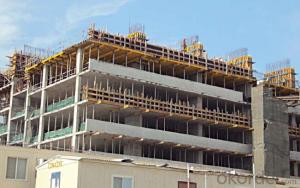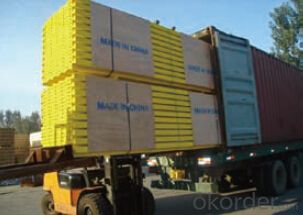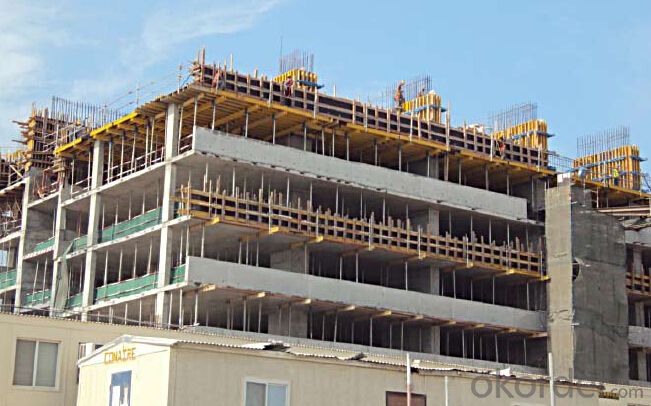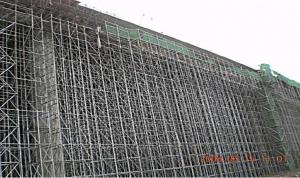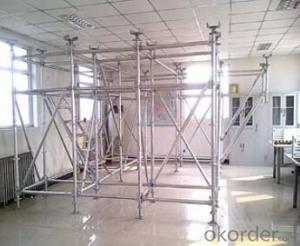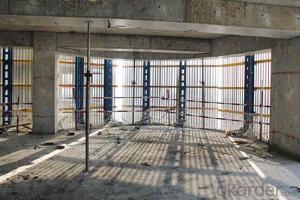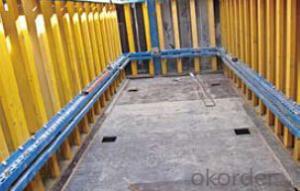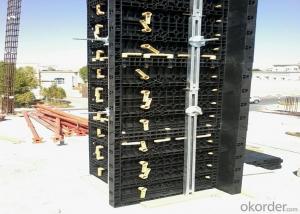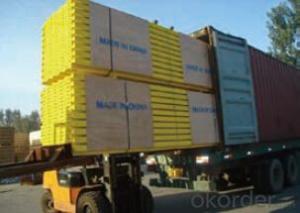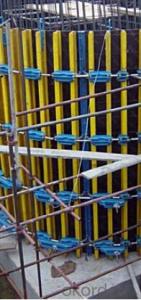Timber Beam Formwork H20 for formwork and scaffolding system
- Loading Port:
- Tianjin
- Payment Terms:
- TT OR LC
- Min Order Qty:
- 50 m²
- Supply Capability:
- 1000 m²/month
OKorder Service Pledge
OKorder Financial Service
You Might Also Like
Characteristics:
◆ Standardized production lines.
Supply capability: 3000m/day, Lmax = 6600mm.
◆ Finger jointing of the flange and web, the strength of timber beam is highly improved.
Max. shearing force failure load:40KN
◆ Well treated to prevent from water penetration or erosion, so the service life maximally
extended.
Normally, CNBM timber beam H20 can be used for 4 to 5 years, the exact using time would
depend on maintenance & storage.
◆ Robust caps at the end of the girders protect against damages.
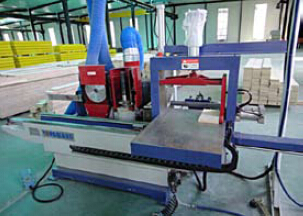
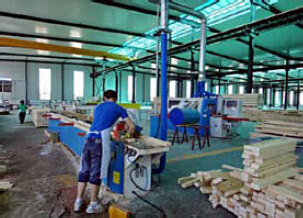
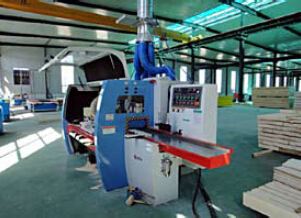
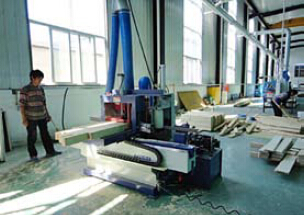
- Q: How does steel formwork contribute to the safety of construction workers?
- Steel formwork plays a crucial role in ensuring the safety of construction workers. Its durability and strength provide a stable and secure working platform, reducing the chances of accidents or injuries caused by unstable structures. In addition, steel formwork is fire-resistant, adding an extra layer of protection in case of fire hazards on construction sites. This not only safeguards the workers but also prevents the spread of fire to nearby structures. Moreover, steel formwork is often prefabricated and can be easily assembled and disassembled. This saves time for workers and minimizes their exposure to potential hazards. The ease of assembly also guarantees proper installation, eliminating the risk of weak or faulty structures that could endanger the workers. Furthermore, steel formwork is equipped with safety features like handrails, guardrails, and non-slip surfaces. These features provide additional protection, preventing falls and accidents when working at heights or on elevated platforms. Lastly, steel formwork is designed to withstand external forces such as wind, earthquakes, and heavy loads. This makes it more resistant to structural failures, reducing the risk of accidents and injuries caused by collapses. Overall, steel formwork greatly enhances the safety of construction workers by offering stability, fire resistance, ease of assembly, safety features, and resilience to external forces. These features ensure that workers can carry out their tasks in a secure environment, minimizing the risks associated with construction activities.
- Q: Can steel formwork be used for both straight and curved walls?
- Steel formwork is versatile and can be utilized for both straight and curved walls. With its exceptional strength and durability, it is ideal for shaping walls of diverse sizes and shapes. Its flexibility allows for effortless adjustments and customization, enabling the creation of both straight and curved walls. The precision and accuracy offered by the steel formwork system ensures that the walls are constructed to the desired specifications. Moreover, the reusability of steel formwork makes it a cost-effective option for projects involving both straight and curved walls.
- Q: What are the different types of formwork bracing used with steel formwork?
- Steel formwork can be supported and stabilized using various types of bracing. These include: 1. Horizontal Bracing: Installed between vertical supports, this bracing provides stability and prevents lateral movement or deformation of the formwork. 2. Diagonal Bracing: By connecting vertical supports diagonally, this bracing adds stability, evenly distributes the load, and prevents twisting or buckling of the formwork. 3. Vertical Bracing: Installed between horizontal supports, this bracing supports the vertical members of the formwork system and prevents vertical movement or deformation. 4. Cross Bracing: This bracing combines horizontal and diagonal support, providing both lateral and diagonal stability. It is commonly used in larger structures or when increased stability is required. 5. Tie Rods: These rods connect the formwork panels and offer additional support. They are placed at regular intervals along the formwork and tightened to ensure that the formwork remains in place during concrete pouring. The selection of formwork bracing depends on project-specific requirements, such as the size and complexity of the structure, as well as the load-bearing capacity of the formwork system. It is crucial to design and install the bracing carefully to ensure the safety and stability of the formwork during construction.
- Q: How does steel formwork accommodate for different concrete pouring heights?
- Steel formwork is a versatile and adjustable system that can easily accommodate different concrete pouring heights. It consists of interlocking steel panels that can be assembled in various configurations, allowing for the creation of customized formwork according to the specific requirements of each construction project. One way steel formwork accommodates for different concrete pouring heights is through the use of adjustable props or supports. These props can be extended or retracted to the desired elevation, providing the necessary support and stability for the formwork. By adjusting the height of the props, the formwork can be easily adapted to accommodate different pouring heights. Additionally, steel formwork often includes adjustable brackets or clamps that can be moved up or down along the vertical bars of the system. These brackets allow for the vertical positioning of the formwork panels, enabling them to be adjusted to the desired height for concrete pouring. Furthermore, steel formwork systems usually have a wide range of panel sizes available, which can be interchanged and combined to achieve the desired height. This flexibility allows for the construction of formwork that perfectly matches the required pouring height, eliminating the need for extensive modifications or customizations. Overall, the adjustable features of steel formwork, such as props, brackets, and interchangeable panels, make it easy to accommodate different concrete pouring heights. This adaptability not only ensures the efficient and precise construction of concrete structures but also saves time and reduces labor costs on construction sites.
- Q: How does steel formwork impact the overall project budgeting?
- The overall project budgeting can be significantly affected by steel formwork. Although the initial cost of steel formwork may be higher compared to wood or plastic formwork, it offers several advantages that can help offset the initial investment. To begin with, steel formwork is renowned for its durability and longevity. Unlike wood or plastic formwork, steel formwork can be reused multiple times without compromising its structural integrity. This reusability factor reduces the need for frequent replacement or repair, resulting in long-term cost savings. Furthermore, steel formwork provides a superior finish to concrete structures. The smooth and even finish achieved with steel formwork minimizes the need for additional surface treatments or finishing work, leading to cost savings. Moreover, steel formwork offers increased strength and stability, enabling the construction of larger and more complex structures. This eliminates the necessity for additional support systems or reinforcements, which can be costly and time-consuming. Additionally, steel formwork is easy to assemble and dismantle, resulting in faster construction times. The quick turnaround time reduces labor costs and allows for earlier project completion, which is particularly advantageous for time-sensitive projects. Lastly, steel formwork is resistant to adverse weather conditions, such as moisture or extreme temperatures, which can negatively impact the effectiveness and lifespan of the formwork. This resistance reduces the risk of formwork damage and replacement costs, contributing to cost savings. In conclusion, while steel formwork may have a higher upfront cost, its durability, reusability, high-quality finish, strength, ease of use, and resistance to weather conditions can all contribute to cost savings in terms of reduced labor, material, and maintenance expenses. Therefore, steel formwork can positively impact the overall project budgeting.
- Q: Is steel formwork suitable for projects with high formwork reusability?
- Projects that require frequent formwork reuse benefit greatly from using steel formwork. Steel formwork is renowned for its durability and strength, enabling it to endure numerous uses without substantial damage. Its assembly and disassembly are effortless, making it highly efficient for reuse on various projects. Moreover, steel formwork guarantees a polished and uniform concrete structure, delivering exceptional quality results. Although steel formwork may initially have a higher price tag compared to alternative formwork types, its extended lifespan and reusability make it a financially prudent choice for projects demanding frequent formwork reuse.
- Q: Can steel formwork be used for power plant construction projects?
- Yes, steel formwork can be used for power plant construction projects. Steel formwork offers high strength, durability, and flexibility, making it suitable for constructing various structures, including power plants. It provides a stable framework for concrete pouring, ensuring the accuracy and quality of the construction. Additionally, steel formwork can be reused multiple times, making it cost-effective for large-scale projects like power plants.
- Q: How does steel formwork handle formwork stripping and demolding?
- Known for its durability and strength, steel formwork is an exceptional option for managing formwork stripping and demolding. The advantages of steel formwork in the formwork stripping process are numerous. To begin with, steel formwork is equipped with a sleek surface that enables the effortless removal of cured concrete. This smooth surface decreases the likelihood of concrete adhering to the formwork, simplifying the stripping process without causing any harm to the structure. Additionally, steel formwork is typically constructed with a system of detachable joints and connections, facilitating efficient formwork stripping. These joints and connections are designed to be easily separated, allowing for swift and uncomplicated removal of the formwork. This feature is particularly advantageous for large-scale construction projects where time is of the essence. Moreover, steel formwork exhibits high resistance to deformation and warping, ensuring that the formwork maintains its original shape during the stripping process. This resistance to deformation helps prevent any distortion or damage to the concrete structure during the demolding phase. Furthermore, steel formwork offers excellent reusability, further enhancing its efficiency in handling formwork stripping and demolding. Once the formwork is stripped, it can be cleaned, repaired if necessary, and reused for subsequent concrete casting. This reusability not only saves time and money but also reduces the environmental impact associated with formwork disposal. In conclusion, steel formwork is specifically designed to handle formwork stripping and demolding effortlessly. Its smooth surface, detachable joints, resistance to deformation, and reusability make it a dependable and efficient choice for construction projects.
- Q: Does steel formwork require any special training or expertise for installation?
- Yes, steel formwork typically requires specialized training and expertise for proper installation. Steel formwork involves working with heavy and rigid materials, as well as understanding the intricacies of its assembly and dismantling process. Adequate knowledge of safety precautions, structural design, and handling equipment is crucial to ensure a successful and secure installation.
- Q: How does steel formwork affect the overall construction site aesthetics?
- Steel formwork can have a significant impact on the overall aesthetics of a construction site. Unlike traditional timber formwork, steel formwork provides a sleek and modern appearance. Its smooth and clean surfaces give a sense of precision and professionalism to the construction site. The use of steel formwork also allows for more flexibility in design. It can be easily shaped and molded into various intricate shapes, resulting in unique and visually appealing structures. This flexibility enables architects and designers to create innovative and eye-catching architectural elements that enhance the overall aesthetics of the construction site. Furthermore, steel formwork can contribute to the overall cleanliness of the construction site. Its durable and reusable nature reduces the amount of waste generated during construction. This not only helps in maintaining a cleaner and more organized site but also reduces the environmental impact of the construction process. Additionally, steel formwork provides a sense of durability and strength to the construction site. Its robust nature ensures that the structures being built are solid and long-lasting. This adds to the overall impression of quality and stability, enhancing the aesthetics of the construction site. In conclusion, steel formwork positively affects the overall construction site aesthetics by providing a modern and sleek appearance, allowing for flexible and innovative designs, contributing to a cleaner site, and enhancing the sense of durability and strength.
Send your message to us
Timber Beam Formwork H20 for formwork and scaffolding system
- Loading Port:
- Tianjin
- Payment Terms:
- TT OR LC
- Min Order Qty:
- 50 m²
- Supply Capability:
- 1000 m²/month
OKorder Service Pledge
OKorder Financial Service
Similar products
Hot products
Hot Searches
Related keywords

